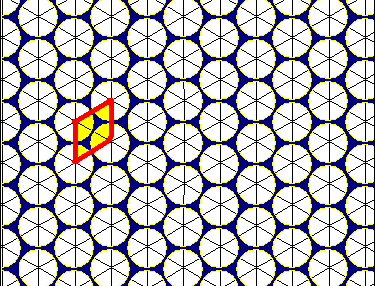Honeycomb Conjecture on:
[Wikipedia]
[Google]
[Amazon]

 The honeycomb theorem, formerly the honeycomb conjecture, states that a regular
The honeycomb theorem, formerly the honeycomb conjecture, states that a regular
 The honeycomb theorem, formerly the honeycomb conjecture, states that a regular
The honeycomb theorem, formerly the honeycomb conjecture, states that a regular hexagonal grid
In geometry, the hexagonal tiling or hexagonal tessellation is a regular tiling of the Euclidean plane, in which exactly three hexagons meet at each vertex. It has Schläfli symbol of or (as a truncated triangular tiling).
English mathematic ...
or honeycomb
A honeycomb is a mass of Triangular prismatic honeycomb#Hexagonal prismatic honeycomb, hexagonal prismatic cells built from beeswax by honey bees in their beehive, nests to contain their brood (eggs, larvae, and pupae) and stores of honey and pol ...
has the least total perimeter
A perimeter is the length of a closed boundary that encompasses, surrounds, or outlines either a two-dimensional shape or a one-dimensional line. The perimeter of a circle or an ellipse is called its circumference.
Calculating the perimet ...
of any subdivision of the plane into regions of equal area. The conjecture was proven in 1999 by mathematician Thomas C. Hales.
Theorem
Let be any system of smooth curves in , subdividing the plane into regions (connected components of the complement of ) all of which are bounded and have unit area. Then, averaged over large disks in the plane, the average length of per unit area is at least as large as for the hexagon tiling. The theorem applies even if the complement of has additional components that are unbounded or whose area is not one; allowing these additional components cannot shorten . Formally, let denote the disk of radius centered at the origin, let denote the total length of , and let denote the total area of covered by bounded unit-area components. (If these are the only components, then .) Then the theorem states that The value on the right hand side of the inequality is the limiting length per unit area of the hexagonal tiling.History
The first record of the conjecture dates back to 36 BC, fromMarcus Terentius Varro
Marcus Terentius Varro (116–27 BCE) was a Roman polymath and a prolific author. He is regarded as ancient Rome's greatest scholar, and was described by Petrarch as "the third great light of Rome" (after Virgil and Cicero). He is sometimes call ...
, but is often attributed to Pappus of Alexandria
Pappus of Alexandria (; ; AD) was a Greek mathematics, Greek mathematician of late antiquity known for his ''Synagoge'' (Συναγωγή) or ''Collection'' (), and for Pappus's hexagon theorem in projective geometry. Almost nothing is known a ...
().
In the 17th century, Jan Brożek
Jan Brożek or Johannes Broscius (November 1585 – 21 November 1652) was the most prominent Polish mathematician of his era and an early biographer of Copernicus. He held numerous ecclesiastical offices in the Catholic Church and was associated ...
used a similar theorem to argue why bee
Bees are winged insects closely related to wasps and ants, known for their roles in pollination and, in the case of the best-known bee species, the western honey bee, for producing honey. Bees are a monophyletic lineage within the superfamil ...
s create hexagonal
In geometry, a hexagon (from Greek , , meaning "six", and , , meaning "corner, angle") is a six-sided polygon. The total of the internal angles of any simple (non-self-intersecting) hexagon is 720°.
Regular hexagon
A regular hexagon is d ...
honeycomb
A honeycomb is a mass of Triangular prismatic honeycomb#Hexagonal prismatic honeycomb, hexagonal prismatic cells built from beeswax by honey bees in their beehive, nests to contain their brood (eggs, larvae, and pupae) and stores of honey and pol ...
s. In 1943, László Fejes Tóth
László Fejes Tóth (, ; 12 March 1915 – 17 March 2005) was a Hungarian mathematician who specialized in geometry. He proved that a lattice pattern is the most efficient way to pack centrally symmetric convex sets on the Euclidean plane (a ge ...
published a proof for a special case of the conjecture, in which each cell is required to be a convex polygon
In geometry, a convex polygon is a polygon that is the boundary of a convex set. This means that the line segment between two points of the polygon is contained in the union of the interior and the boundary of the polygon. In particular, it is ...
. The full conjecture was proven in 1999 by mathematician Thomas C. Hales, who mentions in his work that there is reason to believe that the conjecture may have been present in the minds of mathematicians before Varro.
It is also related to the densest circle packing
In geometry, circle packing is the study of the arrangement of circles (of equal or varying sizes) on a given surface such that no overlapping occurs and so that no circle can be enlarged without creating an overlap. The associated ''packing den ...
of the plane, in which every circle is tangent to six other circles, which fill just over 90% of the area of the plane.
The case when the problem is restricted to a square grid was solved in 1989 by Jaigyoung Choe who proved that the optimal figure is an irregular hexagon.
See also
*Weaire–Phelan structure
In geometry, the Weaire–Phelan structure is a three-dimensional structure representing an idealised foam of equal-sized bubbles, with two different shapes. In 1993, Denis Weaire and Robert Phelan found that this structure was a better solutio ...
, a counter-example to the ''Kelvin
The kelvin (symbol: K) is the base unit for temperature in the International System of Units (SI). The Kelvin scale is an absolute temperature scale that starts at the lowest possible temperature (absolute zero), taken to be 0 K. By de ...
conjecture'' on the solution of the similar problem in 3D.
References
{{reflist Discrete geometry Euclidean plane geometry Conjectures that have been proved